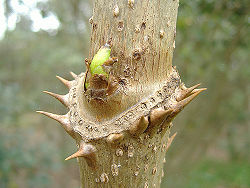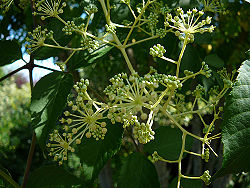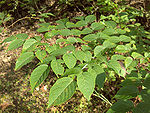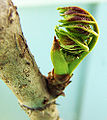Devil's walkingstick
| Devil's walkingstick |
|---|

|
| Scientific Classification |
|
| Binomial Name |
|
Aralia spinosa |
| The Flowers |
Devil's Walking Stick is a species of plant known by the scientific name Aralia spinosa.
Anatomy
The Devil's walking stick is a deciduous shrub or small tree. Coming from a rhizomatous root system is a colony of ash grey stems. Plants that are mature will grow to 20 ft and develop branches. The younger plants just have a stem with all the leaves clustered at the top. Semicircular leaf scars and sharp tooth like spines that are ringed around the stem. The bi- tripinnate leaves are 3-6 ft long and have a exotic ferny look. They grow off of branches that are spiny and the stems are spiny also. The oval shaped leaflets have pointed tips and toothed edges and are 2-4 inches long. On the top of the leaf it is a dark green and underneath it is a whitish color and in the fall it turns burgundy.[1]
Reproduction
The devil's walking stick reproduces by vegetative reproduction with underground rhizomes. It's first time reproducing usually occurs when plants are 3.5 years old. The flowers on it are small, perfect, numerous and occurs in large clusters. They usually bloom in mid summer depending on where they are at. The flowers pinnacle are 30-46 cm long. On the hairy stalk there is five sepals, five reflex petals, and five stamens. This is what the flower is composed of. There are five styles of inferior ovaries united at the base.[2]
The fruits of the tree are purple-black and are produced in large quantities on pink-red stems, they mature in the late fall. There are seed-like stones in juicy ovoid shaped drupes that are 6.4mm long. Seeds that are sown outdoors in the fall or from suckers taken in the late winter and root cuttings in late fall and overwintered upside down in the sand are propagated species. Germination of seeds that are stored require 3-5 months stratification followed by 1-4 months at 20 degrees celsius. [3]
Ecology
The devil's walking stick grows best in the deep loam, but it also grows well in rocky, sandy, or clayey soils and handles a wide pH range. They will grow stronger and sturdier in poor soil but it is luxuriant in rich soil also. To cause a vigorous new growth you will need to mow, cut, or burn it. Early in the fall Margined blister beetles defoliate the plants. This species may grow in full sun or the shade, but prefers the semi-shade. They can't grow in extended flooding or in long-term dessert like dryness. It seems to grow well on a full range of mesic sites. Like low spots that always seem to be moist with seepage, or well drained hill-sides that drain out well in droughts. This trees hardiness zone is 5-9. When it freezes stems usually die back to ground level. The tender young foliage is most likely to be burned back by a late frost. As soon as the seeds are rip from spring germination they should be sown in a cold frame. To germinate a seed it will need to be stratified for 3-5 months and also 1-4 months at 68ºF. You take the three inch root cuttings in the late fall, overwintered upside down in a pot of sand, then re-potted in the spring. [4]
Usage
The devils walking stick is a good accent plant or for tropical effects. The Indians and early settlers used the bark, roots and berries for medical purposes. They used the bark as a purgative and the berries for a painkiller. The plant has been used to treat boils, fevers, toothache, cholera, eye problems, skin condition, snakebite, and various diseases. In the late afternoon the leaves of the tree are covered in honey bees. Birds, black bears, and other wildlife use the berries of the tree for food. [5]







